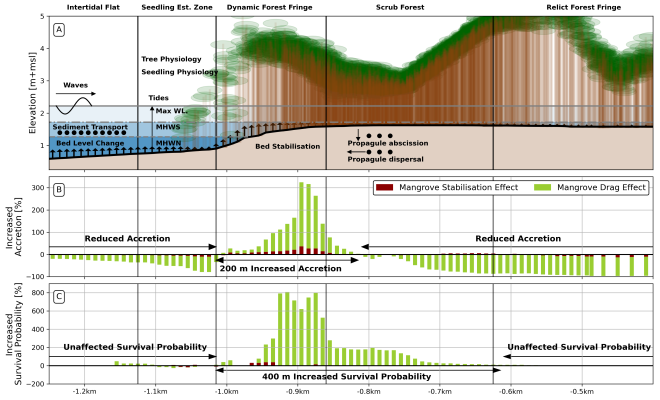R. Gijsman1*, E.M. Horstman1, A. Swales2, D. van der Wal1,3 and K.M. Wijnberg1
1 University of Twente, The Netherlands; 2 NIWA, New Zealand; 3 NIOZ, The Netherlands
* Corresponding author: rik.gijsman@utwente.nl
Introduction
Mangroves reduce energy of long and short-period waves with their above-ground biomass, while they increase soil binding and stability of intertidal flats with their below-ground biomass. This ‘ecosystem engineering’ capacity of mangroves can support shoreline stabilization and forest recovery and development, thereby enhancing their persistence to reduce coastal flood risk (Gijsman et al., 2021). The persistence of mangroves under environmental change is an important reason for the recognition of mangroves as a Nature-based Solution (NbS) for coastal flood risk reduction. However, there is limited quantitative knowledge on how ecosystem engineering of mangroves influences the development of mangrove forests and, as a result, their persistence (Gijsman et al., 2023). Consequently, the persistence of mangrove forests over seasonal to decadal timescales cannot yet be predicted with sufficient confidence so that they can be applied in coastal engineering and management for flood risk reduction.
Objective and Methods
This study aims to develop quantitative knowledge of mangrove ecosystem engineering effects through a biophysical process-based numerical modeling approach. The model is developed with a comprehensive dataset of hydrodynamic, morphodynamic and vegetation parameters collected for over a decade in the Firth of Thames estuary in Aotearoa New Zealand (hereafter Firth). The hydro- and morphodynamic model is setup in Delft3D Flexible Mesh and includes the influence of mangroves’ above-ground biomass (enhancing drag) and their below-ground biomass (stabilizing the bed), as well as the ecological process of seedling recruitment. The Firth is a sediment-rich and wave-dominated estuary with an alongshore uniform, mono-species mangrove forest (Avicennia marina var. australasica). The mangrove forest in the Firth is characterized by distinct cross-shore zones with different elevation and vegetation characteristics: from the most seaward intertidal flat, to the seedling establishment zone, the dynamic forest fringe, the scrub forest and, most landward, the relict forest fringe (Figure 1A) (Swales et al., 2019). Manipulated model simulations with and without mangroves’ effects on hydrodynamics and morphodynamics were performed to quantify their influence on the profile morphology (i.e., sediment accretion) and on forest recovery and development (i.e., seedling survival probability) in these different cross-shore zones on an annual timescale.
Results
The model simulations identified three distinct cross-shore zones for the mangrove ecosystem engineering effects on the morphodynamics and forest recovery and development: the lower-elevated unvegetated intertidal flat and sparsely-vegetated seedling establishment zone, characterized by daily tidal inundation (zone 1: the mudflat); the mid-elevation denser-vegetated dynamic forest fringe, characterized by daily to biweekly tidal inundation (zone 2: the fringe); and at the highest elevation, the densely-vegetated scrub forest and relict forest fringe, with fewer than biweekly tidal inundation (zone 3: the forest}. The presence of mangrove trees increases sediment accretion in the fringe, up to a distance of approximately 200 m landward from the forest fringe/mudflat transition (Figure 1B). The presence of mangrove trees also enhances the survival probability of seedlings, and this effect extended about 400 m landward of the forest fringe/mudflat transition (Figure 1C). The existing upper intertidal platform morphology and forest zonation in the Firth were found to be directly related to these mangrove ecosystem engineering effects on sediment accretion and seedling recruitment. Overall, the results showed that the effects of mangrove ecosystem engineering contribute to forest fringe development and widening of the vegetated upper intertidal platform, thus enabling mangrove persistence to reduce coastal flood risk.

Figure 1: (A) Mangrove ecosystem engineering effects on sediment accretion and seedling survival probability in the Firth of Thames at an annual scale. (B) Effects of mangrove bed stabilization and drag on vertical sediment accretion and (C) seedling survival probability are presented relative to simulation results for the same initial and boundary conditions but without mangrove tree effects.
References
Gijsman et al., (2021). Nature-Based Engineering: A Review on Reducing Coastal Flood Risk with Mangroves, Frontiers in Marine Science, 8, 825
Gijsman et al., (2023). Mangrove Drag and Bed Stabilisation Effects on Intertidal Flat Morphology, Earth Surface Processes and Landforms, 1-18
Swales et al., (2019). Landscape evolution of a fluvial sediment-rich avicennia marina mangrove forest: insights from seasonal and inter-annual surface-elevation dynamics. Ecosystems 22, 1232-1255


